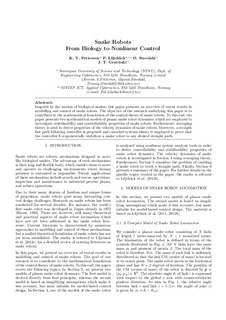| dc.contributor.author | Pettersen, Kristin Ytterstad | |
| dc.contributor.author | Liljebäck, Pål | |
| dc.contributor.author | Stavdahl, Øyvind | |
| dc.contributor.author | Gravdahl, Jan Tommy | |
| dc.date.accessioned | 2017-11-29T09:35:16Z | |
| dc.date.available | 2017-11-29T09:35:16Z | |
| dc.date.created | 2013-09-24T14:13:48Z | |
| dc.date.issued | 2013 | |
| dc.identifier.citation | Elsevier IFAC Publications / IFAC Proceedings series. 2013, 9 (1), 110-115. | nb_NO |
| dc.identifier.issn | 1474-6670 | |
| dc.identifier.uri | http://hdl.handle.net/11250/2468356 | |
| dc.description.abstract | Inspired by the motion of biological snakes, this paper presents an overview of recent results in modelling and control of snake robots. The objective of the research underlying this paper is to contribute to the mathematical foundation of the control theory of snake robots. To this end, the paper presents two mathematical models of planar snake robot dynamics, which are employed to investigate stabilisability and controllability properties of snake robots. Furthermore, averaging theory is used to derive properties of the velocity dynamics of snake robots. Moreover, a straight line path following controller is proposed and cascaded systems theory is employed to prove that the controller K-exponentially stabilizes a snake robot to any desired straight path. | |
| dc.language.iso | eng | nb_NO |
| dc.title | Snake Robots - From Biology to Nonlinear Control | nb_NO |
| dc.type | Journal article | nb_NO |
| dc.description.version | submittedVersion | |
| dc.source.pagenumber | 110-115 | nb_NO |
| dc.source.volume | 9 | nb_NO |
| dc.source.journal | Elsevier IFAC Publications / IFAC Proceedings series | nb_NO |
| dc.source.issue | 1 | nb_NO |
| dc.identifier.doi | 10.3182/20130904-3-FR-2041.00062 | |
| dc.identifier.cristin | 1051795 | |
| dc.relation.project | Norges forskningsråd: 205622 | nb_NO |
| dc.relation.project | Norges forskningsråd: 223254 | nb_NO |
| cristin.unitcode | 7401,90,23,0 | |
| cristin.unitname | Anvendt kybernetikk | |
| cristin.ispublished | true | |
| cristin.fulltext | preprint | |
| cristin.qualitycode | 0 | |
